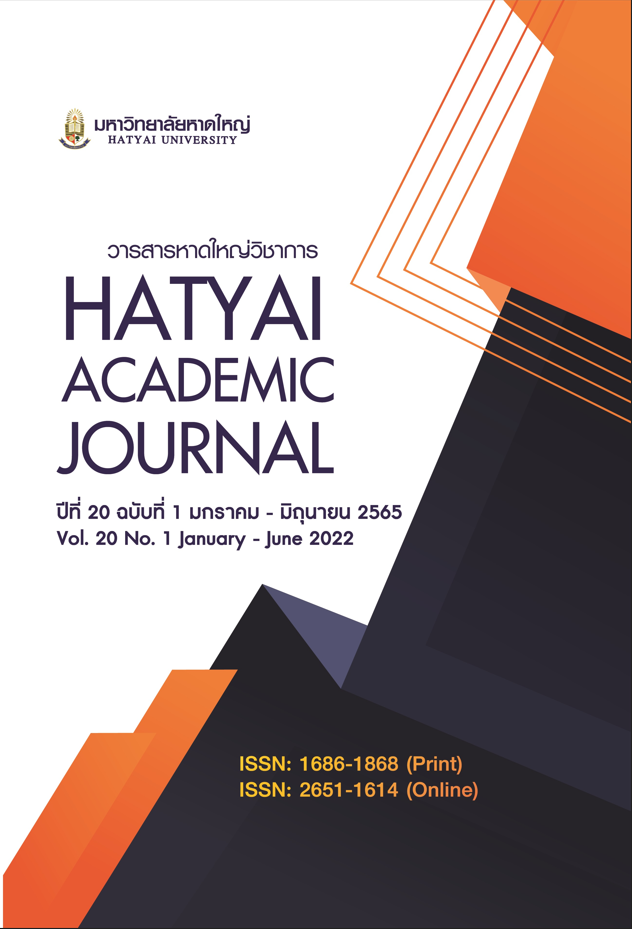Roles and Functions of Families in Caring for Children with Multiple Disabilities and the Government Support
Main Article Content
Abstract
This research focused on 1) the roles and functions of families in caring for children with multiple disabilities and 2) government support for such families. The first sample group was 15 families whose children had both physical and intellectual disabilities aged up to 19 years old. The children cannot help themselves and used to receive services from both public or private educational institutions and communities located in Bangkok and Chonburi provinces. The second sample group was five experts in disability issues policy or service providers for the disabled. Both sample groups were chosen by purposive sampling. A semi-structured interview form and group discussions were used to collect data. Data were analyzed using content analysis. The results of the study showed that the roles and functions of families in the past and present are divided into three areas: 1) caring for family members, 2) promoting the development of children with disabilities according to their ages and 3) management of family crises. Government support for families include five issues: 1) the rights of children with disabilities, 2) guidelines for the development of children with disabilities, 3) creating a career and earning money, 4) integration network, and 5) family expectations.
The results of the study are proposed to guide agencies working with the disabled. By the implementation of this finding, these agencies will be able to adopt a disability policy. Apart from fostering a family network of children with disabilities, they are expected to help each other in various dimensions and empower the disabled to have a better quality of life.
Article Details

This work is licensed under a Creative Commons Attribution-NonCommercial-NoDerivatives 4.0 International License.
All submitted articles are subject to academic validation by qualified experts (peer review). The opinions expressed in each article of this publication are those of the authors themselves. The editorial board holds no responsibilities on them and does not reserve the copyright for academic use with the condition that the reference of their origin is cited.
References
Al-Kandari, H. Y. (2014). Parents’ and professionals’ perceptions of the services of families of children with intellectual developmental disabilities. Child and Adolescent Social Work Journal, 31(2), 119-142
Allen, P. J., Vessey, J. A., & Schapiro, N. A. (2009). Primary care of the child with a chronic condition (5th ed). St. Louis: Mosby-Year Book.
Caldwell, S. M. (1988). Measuring family well-being: Conceptual model, reliability, validity and use. In C. F. Waltz & O. Strickland (Eds.), Measurement of nursing outcome: Volume one: Measuring client outcomes (pp. 396-422). New York, NY: Springer.
Creswell, J. W. (2007). Research design: Qualitative, quantitative, and mixed methods approaches (2nd ed.). Thousand Oaks, CA: Sage.
Department of Empowerment of Persons with Disabilities. (2017). The 5th National Plan for Life Development of Persons with Disabilities (2017-2021). Bangkok: Department of Empowerment of Persons with Disabilities, Ministry of Social Development and Human Security. [in Thai]
Dunst, C. J. (2002). Family-centered practices: Birth through high school. The Journal of Special Education, 36(3), 141-149.
Epstein, N. B., Bishop, D. S., & Baldwin, L. M. (1982). McMaster model of family functioning: A view of the normal family. In F. Walsh (Ed.), Guilford family therapy series. Normal family processes (p. 115-141). New York: Guilford.
Isa, S. N., Aziz, A. A., Rahman, A. A., Ibrahim, M. I., Ibrahim, W. P., Mohamad, N., … Van, R. H. (2013). The impact of children with disabilities on parent health-related quality of life and family functioning in Kelantan and its associated factors. Journal of Developmental and Behavioral Pediatrics, 34(4), 262-268.
Leaf, R. B., & Mc Eachin, J. (1999). A work in progress: Behavior management strategies and a curriculum for intensive behavioral treatment of autism. New York: DRL.
Masood, A., Arshad, R., & Mazahir, S. (2015). Families of children with cerebral palsy: Family functioning domains. Int J Sch Cog Psychol, 2(1), 1-6. doi: 10.4172/2469-9837.1000119
Miller, J. E., Nugent, C. N., & Russell, L. B. (2015). Risk factors for family time burdens providing and arranging health care for children with special health care needs: Lessons from nonproportional odds models. Social Science Research, 52, 602-614.
Pousada, M., Guillamón, N., Encuentra, E. H., Marron, E. M., Redolar-ripoll, D., Angles, M. B, & Gómez-Zúñig, B. (2013). Impact of caring for a child with cerebral palsy on the quality of life of parents: A systematic review of the literature. J Dev Phys Disabil, 25(5), 545-577.
Teeraworrawach, W. (2019). Relationship between coping patterns and family well-being of caregivers of child with cerebral palsy. Journal of Mental Health of Thailand, 27(3), 145-158. [in Thai]
Vijayasamundeeswari, P., Venkataraman, P., David, A., & Ravindran, O. S. (2018). Family functioning and disability: A study on mothers of mentally disabled children. South East Asia Journal of Medical Sciences, 2(3), 4-6.
Whittingham, K. (2014). Parents of children with disabilities, mindfulness and acceptance: A review and a call for research. Mindfulness 5, 704-709. doi: 10.1107/sI2671-013-0224-8
